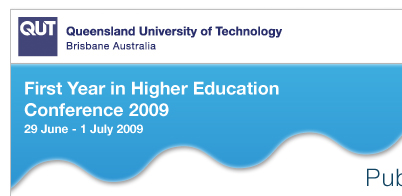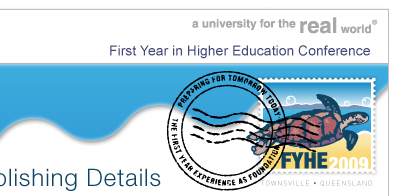Publishing details
Editor: Jason Thomas, Senior Events Manager, QUT Events
Publisher: QUT Publications
E1 Conference papers
While authors need to confirm this information with their own institutions for the purposes of their individual 2009 Research Publications Report, the refereed paper presentations that are published as part of the FYHE Collection for 2009 should be classified as E1 conference papers because they:
Are published or available in full in 2009.
The Higher Education Research Data Collection (HERDC) Specifications require that the research must have been published in the 2009 calendar year, and 2009 must be stated as the year of publication within or on the work being claimed. Our papers satisfy these requirements. The definition of published in this context is the date the publication was released to its intended audience; namely 2009 for this year’s conference. A page showing the stated year of publication is included in the publication.
Meet the HERDC Definition of Research
This definition appears at section 1.3.9 of Higher Education Research Data Collection (HERDC) Specifications which states that research comprises: creative work undertaken on a systematic basis in order to increase the stock of knowledge, including knowledge of man, culture and society, and the use of this stock of knowledge to devise new applications [OEDC (2002), Frascati Manual: Proposed Standard Practice for Surveys on Research and Experimental Development, OEDC: Paris]; any activity classified as research which is characterised by originality; it should have investigation as a primary objective and should have the potential to produce results that are sufficiently general for humanity's stock of knowledge (theoretical and/or practical) to be recognisably increased. Most higher education research work would qualify as research; pure basic research, strategic basic research, applied research and experimental development).
Only be counted once by each HEP
e.g. if a conference paper is published in conference proceedings and is subsequently included as a chapter in a book, it can be counted as a chapter or as a conference paper but not both
and be characterised by:
- substantial scholarly activity, as evidenced by discussion of the relevant literature, an awareness of the history and antecedents of work described, and provided in a format which allows a reader to trace sources of the work, including through citations and footnotes
- originality (i.e. not a compilation of existing works)
- veracity/validity through a peer review process or by satisfying the commercial publisher processes
- increasing the stock of knowledge
Are published in some format in full
The guidelines state that papers may appear in a number of different formats, eg.
- A volume of proceedings
- A special edition of a journal
- A normal issue of a journal
- An edited book
- A monograph
- Conference CD-ROM
- Conference or organisational web site.
- Our format satisfies the HERDC requirements.
Are peer-reviewed
The HERDC guidelines state that an acceptable peer review process is one that involves an assessment or review of the research publication in its entirety before publication by independent, qualified experts. Independent in this context means independent of the author. All refereed papers at this conference have been double blind peer reviewed, independently of the author(s).
Are presented at a conferences of national and international significance
This information is based on the 2009 HERDC Specifications for the collection of 2008 data.
E1 conference papers should also meet the General Publication Requirement for inclusion in the 2009 HERDC.
Retrieved June 23, 2009 from the 2009 HERDC Specifications for Collection of 2008 data.



